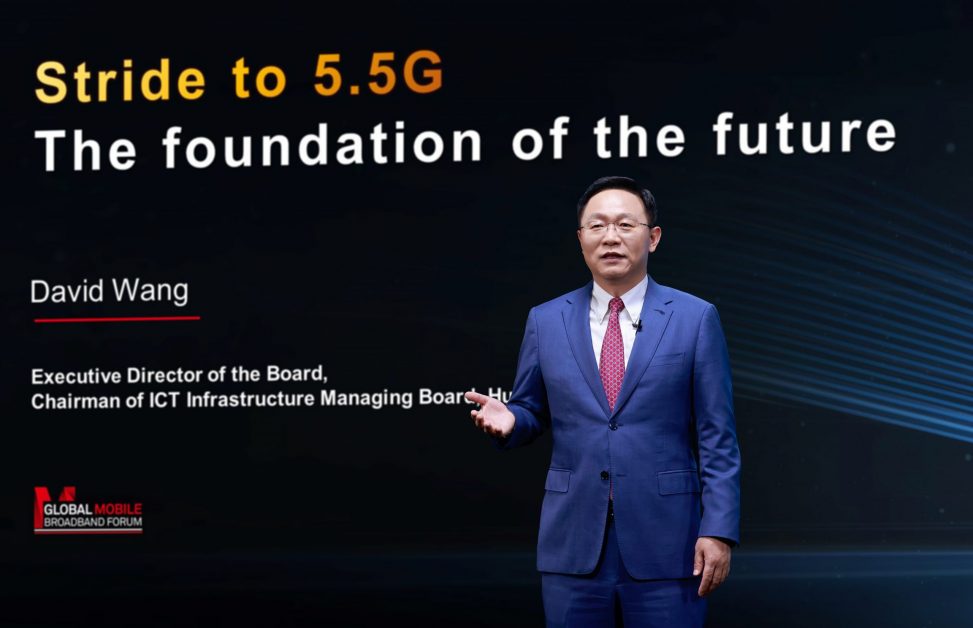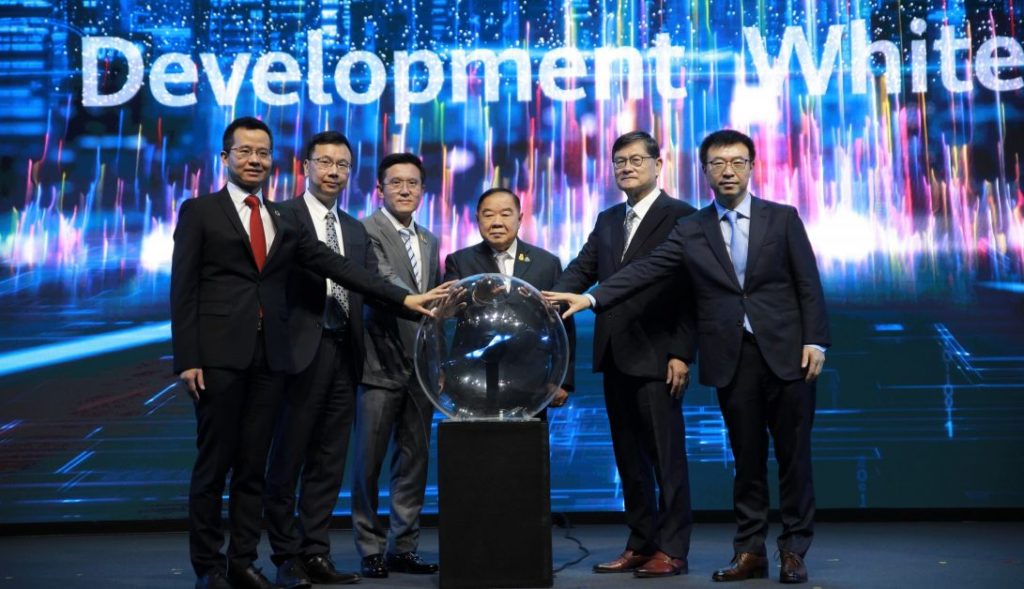During the Global MBB Forum 2022, David Wang, Huawei’s Executive Director of the Board and Chairman of ICT Infrastructure Managing Board delivered a keynote speech titled Stride to 5.5G: The foundation of the future. David Wang noted how, through concerted efforts, the industry has made significant progress and is ready to make the leap to 5.5G. To hit this milestone, Wang called upon all industry players to prepare on all fronts, so that we can move faster towards the 5.5G era and eventually build a better, intelligent world together.
With the intelligent world fast approaching, the rapid changes we are set to experience will all be accompanied by increasing requirements for digital infrastructure. The next milestone we must hit on the path to the intelligent world is 5.5G. 5.5G will deliver 10 Gbit/s experiences, support hundreds of billions of connections, and help us achieve native intelligence.
Wang emphasized, after two years of concerted efforts across the industry, 5.5G has seen huge progress and three things have become clear.
First, the standardization of 5.5G has been initiated and is on right on track, making it more than just a vision.
Second, the industry has made breakthroughs in key technologies for 5.5G, and ultra-large bandwidth and ELAA can now deliver 10 Gbit/s experience.
Third, the industry has a clear vision for the IoT landscape. Three types of 5.5G-enabled IoT technologies supported by 5.5G, namely NB-IoT, RedCap, and passive IoT, are developing rapidly and will support numerous IoT connections.
“The communications industry is constantly evolving. 5.5G has been kicked into high gear. Looking ahead, our task is to tackle these five new areas – standards, spectrum, products, ecosystems, and applications. Together, let’s stride to 5.5G and build a better, intelligent world,” stressed Wang.
First, we need to set standards and promote key technological research.
Standards steer the mobile communications industry and will guide the 5.5G industry forward along a clearly defined path. We must work to ensure that Release 18 is frozen by Q1 2024, as planned, and will help 5.5G networks deliver 10 times better performance. Regarding Release 19 and beyond, we should come together to explore what capabilities 5.5G will require in order to support new services and scenarios as we continue to refine 5.5G standards. This will both maximize the potential of 5.5G and extend its lifecycle.
Second, we need to prepare more spectrum for ultra-large bandwidth.
We should fully utilize sub-100 GHz resources to build ultra-large bandwidth. mmWave is a key frequency band for 5.5G. Operators will need to acquire over 800 MHz of spectrum from this band if they are to realize 10 Gbit/s experiences. 6 GHz is also a potential ultra-wide band for 5.5G. When 6 GHz is promoted as an IMT band at WRC-23, it is likely that countries will need to auction off the 6 GHz spectrum. We can also refarm the sub 6 GHz spectrum to achieve ultra-large bandwidth for 5.5G.
Third, we need to prepare for 5.5G with mature networks, devices, and chips.
Both our networks and devices need to be upgraded to deliver 10 Gbit/s experiences. More specifically, our products will rely on ELAA technologies that can support over 1,000 antenna arrays suitable for mid- and high-frequency bands, and massive MIMO will be required to support 128T capacity. Additionally, more innovation will be needed in regard to 5.5G chips and devices to make them more intelligent, capable of supporting 3T8R, or even more channels, and able to aggregate more than four carriers.
Fourth, we need to work together to build a thriving 5.5G ecosystem.
This thriving ecosystem will better address digital requirements in all scenarios. Take the 5.5G-enabled IoT ecosystem as an example. Operators and equipment vendors will need to improve plans for 5.5G networks in order to better connect both people and things, while device vendors must adapt costs and modular capabilities to application scenarios. In addition, industry and app developers will need to act immediately to start incubating new apps.
Fifth, we should continue our work on groundbreaking applications.
As our standards, spectrum, products, and ecosystem mature, 5.5G will become a reality, allowing even more applications to emerge. Multi-sensory interactions will transform the way we communicate. Intelligently connected vehicles are set to become a third mobile space and see wide adoption, while intelligent connections across industries will lead to the dissolution of information silos, driving industrial upgrade. A new generation of innovative applications is now emerging, and our vision for the intelligent world is becoming clearer. That’s why all industry players need to work together towards the exploration and creation of these applications.
Deputy Prime Minister General Prawit Wongsuwan gave a speech during an Opening Ceremony of The 13th Global Mobile Broadband Forum 2022 “It is my great pleasure and honor to preside over the opening ceremony of the annual event for the global ICT industry, the 13th Global Mobile Broadband Forum 2022, held in Thailand for the first time. This event is considered as an important stage for private and government sectors to share experiences and valuable opinions to drive development of the country and the industrial sector. Throughout the past year, the government has been focusing on the development of digital infrastructure that is fundamental for the country’s development towards a digital economy. Therefore, the government has implemented digital infrastructure development policies to drive Thailand 4.0, which are: ‘Promote and Invest in Digital Infrastructure’ and ‘Nurturing digital workforce’. I am confident that today’s forum aligns with the government’s policy to develop digital systems to drive Thailand’s economy and society. In addition, it will spark idea and benefit the joint development of digital technology infrastructure in a comprehensive and sustainable way.”
In addition, Huawei, in partnership with MDES and MHESI, unveiled the Thailand Digital Talent Development whitepaper to ‘Transform Thailand into ASEAN Digital Powerhouse’ at the event. The whitepaper is co-developed by Huawei and Roland Berger, based on in-depth interview of nearly 40 private and public sectors in Thailand’s digital talent industry, which aims to help Thailand build a comprehensive technical know-how of the digital talent landscape. It will provide systemic insights into digital industry trends, digital industry skill requirements, and current talent supply and gaps in Thailand in order to provide sustainable policy recommendations on talent policies, talent development paths, and action plans. This whitepaper demonstrates Huawei’s continuous social value contributions to Thai talent development and enablement in aid of Thailand’s digital transformation ecosystem. Huawei is committed to not only helping prepare existing digital talent for the future, but also addressing the problem of digital skill shortages by grooming the next generation of digital talents in Thailand, as the country rapidly moves towards becoming the digital hub of ASEAN.
The Global Mobile Broadband Forum 2022 is hosted by Huawei, together with its industry partners GSMA and GTI. This annual forum gathers mobile network carriers, vertical industry leaders, and ecosystem partners from around the world to discuss how to make 5G a commercial success and other hot topics like green development, intelligence, and 5G evolution. For more information, please visit: https://www.huawei.com/en/events/mbbf2022
Source: Carl Byoir & Associates

